Susan U. Neal's Blog, page 9
August 1, 2022
How to Keep Yourself from Becoming Overwhelmed
Are you tired of becoming overwhelmed? What would it take for you to live more often in serenity and less often becoming overwhelmed? It’s a common greeting — “How are you?” You can almost predict the response. “Busy. Keeping busy.” Imagine saying, “Well, rested, and focused.” Overwhelm is a choice. Perhaps more insidious, it distracts ... Read more
The post How to Keep Yourself from Becoming Overwhelmed first appeared on .July 21, 2022
A Calm Life is a Strong Life
Almost 13 years ago to the day, I flew over 6,000 miles to learn one valuable lesson: a calm life is a strong life.
“And I saw that all toil and achievement spring from one person’s envy of another. This too is meaningless, a chasing after the wind. Fools fold their hands and ruin themselves. Better one handful with tranquility than two handfuls with toil and chasing after the wind.”
-Ecclesiastes 4:6, NIV

It was a beautiful, sunny day where the wind was whirling with crisp whispers. I sat down on a carpet of soft, green grass, surrounded by the Bernese Alps. I had to take it all in. Just sixteen days earlier, my husband had surprised me with a 30-day trip to Europe to celebrate twenty-five years of marriage.
Thirty days.
With absolutely no warning, I had to shift an entire month filled with responsibilities and urgent matters. Most women would be overwhelmed with joy, but I found myself overwhelmed with anxiety. What about all my commitments and responsibilities at church? If I don’t attend the summer trainings, I won’t be able to teach or lead any of the women’s events. I must be at that training.
At that time in my life, missing out on anything seemed like messing up on everything.
“I can’t go away for that long,” I said. “What on earth were you thinking?”
My inner panic completely overtook the beauty of my husband’s most generous gift.
“I don’t know,” my husband smiled. “Something overwhelmed me, and I clicked, ‘yes,’ and here we are. It’s twenty-five years. That needs to be celebrated.”
My twenty-something twins were sitting at the table, watching this unfold.
“Mom, you could say, ‘thank you,’” my son spoke. “Really?”
His twin sister sat quietly.
When Nature Invites into a Calm Life“Women need solitude in order to find again the true essence of themselves.”
-Anne Morrow Lindbergh, Gift from the Sea
With the fresh memory of that conversation in mind, I brushed my hand over the verdant blades of grass, praying softly to God. As I did, I felt something nestled deep in the grass. I pulled it out and held it up to my face. It was a small snail.
As I admired the variegated hues of brown and studied the spiral pattern on its shell, I thought of its simplicity. It reminded me of the beautiful Tiger Moon Shells collected from Cape Hatteras National Seashore.
I turned it round and round and thought of its quiet existence. I couldn’t help but wonder if it was waiting there for me.
For some odd reason, I placed it on the palm of my left hand, reached for my phone, and snapped a simple photo. It spoke to a deep place in my languished soul. I think you have more to say, I thought. Let’s tuck you away and take you home. I have a special place for you on my desk. I want to remember this sacred moment.
In that sacred moment, I recalled the words of my daily devotion, written by the wise Oswald Chambers in his classic, My Utmost for His Highest. They fell on my heart, yet left me hungering to understand why. “Jesus Christ calls service,” he writes, “what we are to Him, not what we do for Him. It is like a corn of wheat, which falls into the ground and dies, but presently it will spring up and alter the whole landscape.”
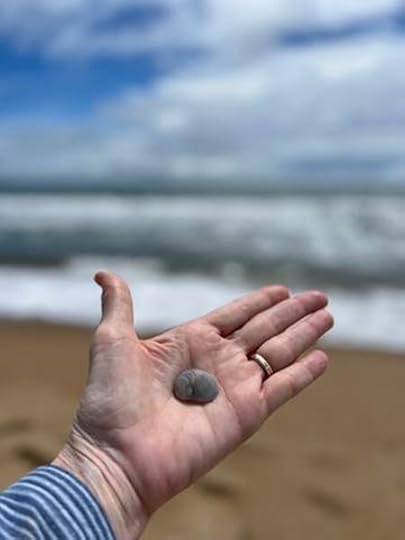
Little did I know Chamber’s words would become so literal in my life. It seemed my husband’s surprise gift held an even deeper gift. One that I would keep unwrapping.
God was altering the entire landscape of my inner life, inviting me to grasp what it truly means to be a human being, not a human doing.
First and foremost, this trip showed me I don’t want to live the next twenty-five years of my life in the same way as the last twenty-five years. Oh, don’t get me wrong, they have been blessed beyond measure, but the dominant characteristic of these years is my constant state of “over” doing. I concluded I am moving out of “The Land of Over”:
OverdoOvercommitOver scheduleOver-the-top goal setting (unreasonable goals)Overeat (binge-eating sweets at night, which typically leads to Candida and Candida infection in my body)Overspend on the un-necessities (is this a word?)Overachieve (ouch! this one hurts the most)Over exercise (yes, it’s all about healthy living and a healthy balance)Over analyze (sometimes we must accept the facts/accept in faith)Overstep boundaries (know when to speak/not to speak)A Hyper Life is an Imbalanced LifeOver, in the Greek, means, “hyper.”
Taking that one step further, we see that hyper means, “seriously or obsessively concerned.”
All in all, it just means, “a bit much; a bit out of balance.”
As I held that little snail in the palm of my hand, my eyes were opened to this truth: a hyper life is an imbalanced life.
I come by this personality quirk quite honestly. I was born with a God-given capacity to achieve (we all are) but somewhere along the journey of my life, something clicked inside of me to take residence in “The Land of Over.” That click became the rhythm by which I paced my life.
This drive to do more, be more and have more, diminished my capacity for tranquility.
The great travesty of this imbalanced rhythm is that it played out in very good things. Excelling, at all costs, is what America is all about. In truth, it plays a similar role within the life of the church, as well.
Perhaps I just needed a change of scenery to see my own unhealthy, imbalanced lifestyle.
This break from the rapid routine which I lovingly called my life was a much needed wake up call.
I blame only myself. I claim full responsibility.
[image error]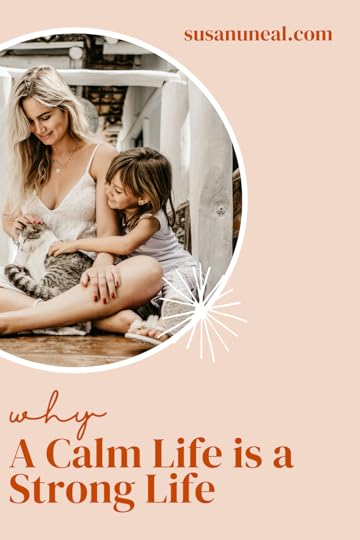
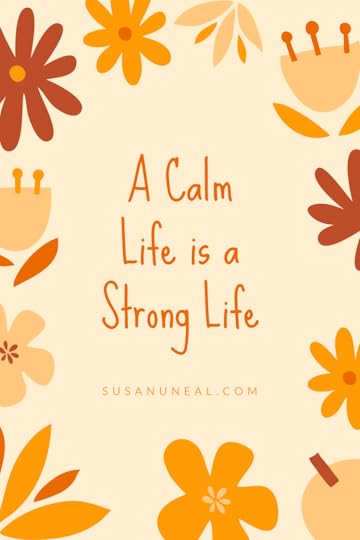 Moving Out Day in the Land of Over
Moving Out Day in the Land of OverWhen I returned home, I “happened” upon a powerful word in the book of Ecclesiastes.
It reads, “Better one handful with tranquility than two handfuls with toil and chasing after the wind.”
For a long time, I wrestled with fifteen words. I asked, “Wait a minute, Lord, isn’t one handful a cop-out if I am capable of two handfuls? I want to be found faithful stewarding the talents you have given me.”
And then, I heard his still small voice say, “My daughter, a calm life is a strong life.”
Today, step outside for a few moments.
Maybe stand barefoot in a patch of lush, verdant grass.
Hold out your two hands before you.
Look at them with tender care.
Consider and meditate on Ecclesiastes 4:6.
Speak this breath prayer aloud:
Lord, may I learn that a calm life is a strong life.
Help me release toil and chasing after the wind. Amen.
Author BioJanell Rardon, aka Professional Heartlifter, is the author of Stronger Every Day: 9 Tools for an Emotionally Healthy You,” and is the host of “Today’s Heartlift with Janell,” a podcast dedicated to integrating faith and mental health. Be sure to grab your free resources and goodies at www.janellrardon.com.
The post A Calm Life is a Strong Life first appeared on .
10 Books to Read That Will Make You Think
Books are one of the most powerful ways to introduce yourself to ideas and develop your mind. Most importantly, books make you think. Here are 10 books to read that will help you cultivate your reasoning skills and supply you with more knowledge.

Have you ever wondered why people do what they do? Why do they always buy a certain brand of toothpaste or take the same route home from work? This book answers those questions and dives deep into why habits exist and how they are formed. The marketing industry has discovered that understanding habits allows you to get inside people’s heads. In fact, there are scientific ways to predict what people want or even what they will do in the future. This book will teach you about human nature and even about yourself. Get ready to have your mind blown as you get a little peek inside other people’s minds.
2. A M essage to Garcia by Elbert HubbardElbert Hubbard, a small-town newspaper publisher, wrote this little book one evening in less than an hour. The next morning, he printed it without a title as a filler for a blank page in the town’s magazine. To his shock, orders started flooding in for his article, and it soon had over 40 million reprints. Since then, A Message to Garcia has sold over a hundred million copies, been translated into every major language, and become the basis for two films. So, who even is Garcia and what’s all the fuss about this little book? Although most people have never heard of this general who served in the Crimean War, the lessons that can be learned from his life are invaluable. You won’t forget this story of an ordinary, but truly outstanding man.
3. How to Win Friends and Influence People by Dale CarnegieDo you want to improve your communication skills and learn how to interact well with others? Do you want people to respect and listen to you? If you answered yes to any of those questions, this book is for you. How to Win Friends and Influence People will teach you the basic principles for interacting well with those around you and becoming a leader. It offers excellent advice on how to treat others with consideration and tips on how to make those around you feel valued and appreciated.
4. The Diary of a Young Girl by Anne FrankWhile many have heard of Anne Frank, a young Jewish girl who wrote about her experiences during the Holocaust, few have read her story. While this book gives insight into what really happened during WWII, it also presents a powerful perspective on value and humanity. This book shows Anne’s struggle with identity as she is subjected to many unimaginable pressures and hardships. This book will make rethink how you view life and those around you.
5. How the Might y Fall by Jim CollinsHave you ever wondered what makes people successful? Why do some companies thrive while others, even popular ones, decline? This book dives deep into the essence of what makes or breaks businesses and how to avoid decay. But it also goes beyond just businesses and explores what it takes to be a successful leader in any area of life.


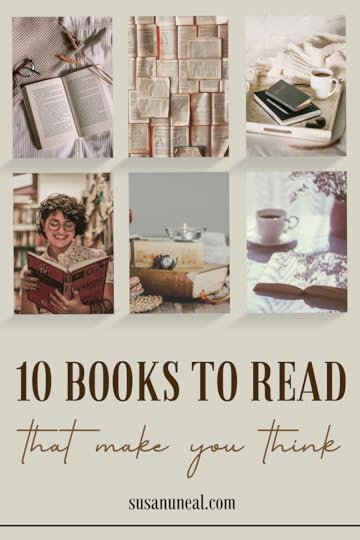 Fiction Books
Fiction BooksStories are one of the most powerful methods of communication. They can make you laugh, cry, or think. Here are a few fictional works that you will want to read again and again.
6. And Then There Were None by Agatha ChristieLove a mystery? This book will keep you on your toes. A worldwide bestseller, it sold over 100 million copies. The adventure begins when eight people receive an unexpected invitation to a small island off the coast of Devon. Although the hosts have not yet arrived, they have left specific instructions for their guests and, oddly enough, an old rhyme. However, disaster strikes as the guests die one by one. But coincidence isn’t enough to explain the deaths, and the guests must face the reality that there is a murderer among them. Unable to get off the island, the remaining guests seek to solve the mystery and as they do, they unravel dark secrets from the past. It’s a race for time. Will they be able to solve the mystery before the last of them is killed? In this story, Agatha Christy masterfully weaves together a suspense-filled plot full of twists and turns. This book will make you question everything you thought you knew.
7. 1984 by George OrwellHave you ever heard the phrase “Big Brother” or the idea that the government is always watching? We have this book to thank for that. Written in 1949, it predicted what the world would come to in just a few short years. And it isn’t a pretty picture. Bleak, isolated, and cold, George Orwell presents a society that has lost its moral foundations and personalities. People no longer have the freedom to act or think for themselves, and the Thought Police force everyone to conform to a certain standard. While it may seem extreme, 1984 warns readers of the danger of totalitarianism and the threat of complete government control.
8. Pride and Prejudice by Jane AustenPride and Prejudice is a classic love story with charming characters and an engaging plot. Although some claim that a work written in the 1800s must be outdated, its universal themes appeal to every audience and continue to capture the attention of modern readers. This book shows how people can overcome societal norms and their own preconceptions to find true love and happiness. It will make you rethink how you view those around you. Filled with charm and wit, this book has all the characteristics of a true classic.
9. Jane Eyre by Charlotte BronteWritten at a time when society’s expectations shaped how people thought and acted, this novel challenged what most considered to be acceptable and revolutionized the core beliefs of that time. Gothic elements are woven throughout it, as well as mystery, suspense, and intrigue. It offers an in-depth look at some challenges faced by people of previous generations so we can make better choices for the future.
10. Brave New World by Aldous HuxleyHave you ever wondered what the future will look like? If genetic modification and machines replace natural processes, how would society respond? Written by a man with in-depth insight into both culture and human nature, this book shows how life could change in an advanced, technologically driven world…
If you want to discover more exciting books but don’t know where to start, check out some of these other book ideas . . .
Top 12 Books to Read in 202116 Best-Selling Books to Read in 202010 Best Audiobooks to Listen to in 2020Holiday Gift Guide for Book LoversAbout the Author
Ryleigh Wood is an avid reader and a student majoring in Professional Writing. She loves discovering new books and constantly challenging her mind with fresh ideas and perspectives.
The post 10 Books to Read That Will Make You Think first appeared on .July 8, 2022
What is “Christian” Yoga? | Combining Faith + Yoga
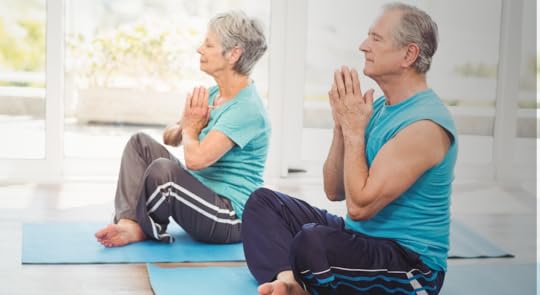
“Christian” yoga is an oxymoron. To some, it seems to contradict one’s Christian faith. Yet there is more to yoga than most realize. The physical, mental, and emotional benefits are fascinating, and it can draw one close to God, and God will draw near to you (James 4:8). I hope this article will enlighten your perspective on yoga.
When did yoga originate?Origins of yoga can be found on stone seals that archaeologists uncovered from the excavation site of the Indus Valley Civilization (India/Pakistan). This archaeological evidence dates yoga back to around 3000 BC, which is before the establishment of Hinduism and Buddhism. From a biblical timeframe this would have been after the flood but before the birth of Abraham.
Around 1500 BC the Hindu religion created the term yoga. Buddhism began its association with the use of physical postures and meditation around 600 BC. Therefore, yoga postures were performed by humans hundreds of years before Hinduism and Buddhism existed. Isn’t that amazing!
Why does yoga have a bad rap with Christians?The exercises and stretches in yoga are designed to bring one to a place of meditation so you can yolk or join with the spiritual realm. Yoga means yoking together. The Hindu and Buddha religions realized this and incorporated yoga into their practices.
When a Christian practices yoga, it prepares the mind to hear from God. Finally, you are quiet and not worrying about your troubles. So you can listen to the Lord’s still, small voice. How often do we take time to listen to God?
Some people believe participating in yoga may unwittingly lead a person to yoke, or join to the spiritual realm in an undesirable way and expose them to dark spiritual forces (Ephesians 6:12). Dr. Kevin Flynn, an Anglican priest, responded to this premise by saying, “Are baptized Christians, nourished by God’s word really so susceptible to dark forces? I think not.”
God knows our hearts. He knows who we are worshiping. Exercising a certain way, including yoga posturing, is not wrong or sinful because God evaluates what is in a person’s heart (Mark 7:14–15, 20–23).
Interestingly, physical posturing such as bowing and laying face down and meditation have also been associated with the Jewish and Christian faiths (Exodus 4:31, Psalms 1:2, and Psalms143:5). Yoga posturing was not associated with Christianity until our era. Christian meditation is foundationally focused on God and his Word, and this is the focus of Christian yoga.
God-Focused YogaA form of Christian yoga, Scripture Yoga , is different from secular yoga because you listen to God’s Word as it is recited in the yoga class. Participants meditate on Bible verses while holding yoga poses. This allows their heart and mind to be open to God. To provide others with the peace I found through Christian yoga, I’ve published two yoga books, two Christian yoga DVDs, and two yoga decks.
, is different from secular yoga because you listen to God’s Word as it is recited in the yoga class. Participants meditate on Bible verses while holding yoga poses. This allows their heart and mind to be open to God. To provide others with the peace I found through Christian yoga, I’ve published two yoga books, two Christian yoga DVDs, and two yoga decks.
Check out ten beginner yoga poses I provide in this blog post Yoga for Beginners.
Other forms of Christian yoga incorporate other aspects of Christianity such as playing Christian music, meditating on a Bible verse at the beginning, during, or the end of class. Others might incorporate a Christian theme in their class. There are numerous ways to impart Christianity into a yoga session. A Christ-centered approach allows you to enjoy the physical benefits of yoga and experience communion with the Spirit of God.
The spiritual benefits of Christian yoga include:
• getting closer to God (James 4:8)
• feeling God’s peace (Isaiah 26:3)
• casting your worries and cares to God (1 Peter 5:7)
• spending time with God.
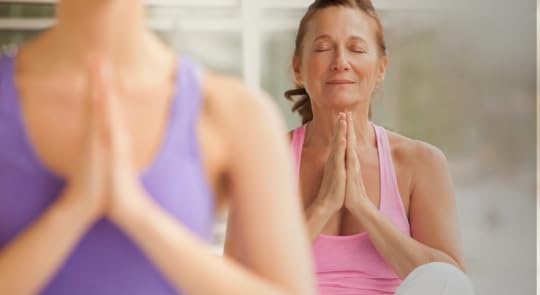 What are the benefits of yoga?
What are the benefits of yoga?Yoga has profound benefits. It helps regulate and improve the functioning of numerous body systems including the immune, respiratory, musculoskeletal, endocrine, circulatory, and metabolic.
• Augments Muscles Tone, Definition, Strength, and Physical Fitness: muscles become well-defined, and the additional strength helps to prevent injuries.
• Expands your Range of Motion in Joints: yoga prevents muscle and joint stiffness.
• Prevents Cartilage and Joint Breakdown: the full range of motion performed during the poses supports joints.
• Improves Coordination and Improves Reaction Time: muscles become stronger and leaner, and balance, coordination, and even reaction time improve.
• Grows your Overall Flexibility: the flexibility of your spine improves your posture, which makes you look younger. It also keeps the spinal disks supple.
• Eases Muscle Pain and Tension: stretching muscles, ligaments, and tendons reduces muscle pain and tension.
• Lessens Pain: several medical studies have shown that yoga reduces back pain, arthritis, fibromyalgia, and other chronic conditions.
• Relieves Stress, Tension, and Anxiety: yoga creates inner peace, so perform yoga to relieve stress before taking anti-anxiety medication, as you may not need even need it.
• Improves Depression: some studies have found yoga increases serotonin levels, which makes you feel happier.
• Improves Memory: focusing on the breath and the present moment, through meditation, enhances concentration, and memory.
• Alleviates Migraines: yoga helps relieve migraines, so try yoga before medication.
• Deepens Sleep: no more tossing and turning, just sound sleep.
• Enhances Lung Function: usually one does not think about respiration, but during yoga class you do. In turn, this enhancement gives you more energy and vitality!
• Expands Circulation: exercise increases the heart rate, and this delivers more oxygen to the whole body.
• Reduces Blood Pressure: medical studies have proven that doing yoga decreases blood pressure.
• Lowers Blood Sugar: studies have shown diabetics’ blood sugar drop through the practice of yoga.
• Decreases Bad Cholesterol (LDL) and Boosts Good Cholesterol (HDL): studies have demonstrated that the practice of yoga can decrease LDL and increase HDL.
• Improves Metabolism: have you ever thought your metabolism does not work as well as it should? Give it a jump start with yoga.
• Relaxes the Body Systems: focusing on deep breathing throughout the session increases blood flow to all internal organs which lowers breathing and heart rate.
• Increases Immunity: many yoga postures stimulate the lymph system to drain toxins out of the body, which heightens immunity.
The physical and mental benefits of yoga are powerful and have been proven through scientific studies. Yoga helps the body function better and improves overall health.
The most popular type of yoga in the United States is Hatha Yoga in which the Eastern religion and philosophical portion of yoga are entirely separated from the yoga class. In Hatha Yoga, the class is about performing the physical yoga poses and deep breathing. But some secular yoga classes could still include Eastern spiritual qualities.
We are called to be discerning. Any practice, behavior, or form of worship that adversely affects your commitment or devotion to Christ should be avoided. Attend a yoga class and discern for yourself whether any aspects of it make you feel uncomfortable. If it does, do not return to that class, but try another one.
Christian Yoga provides an alternative method of exercise in a spiritually desirable and safe environment. Christian yoga’s focus is to lead one to the highest level of true spirituality which is a relationship with Jesus Christ. It should deepen the believers walk with God. Even so, Christian yoga may not be for everyone. As with all decisions, each person must choose for themselves.
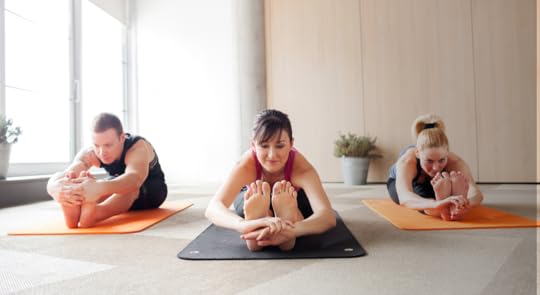
Susan Neal is a certified yoga instructor with over 30 years’ experience in practicing and teaching yoga. She is an RN with an MBA and a masters in health science. As a pursuer of ultimate health, Susan merged her practice of yoga with her passion for God’s Word. Founder of Scripture Yoga Susan recites theme-based Bible verses during her yoga classes.
Susan recites theme-based Bible verses during her yoga classes.
Susan published seven healthy living books, and two are about yoga: Scripture Yoga and Yoga for Beginners; two sets of Scripture Yoga Card Decks, “How to Receive God’s Peace” and “Fruit of the Spirit” and two Christian yoga DVDs, God’s Mighty Angels and What the Bible Says About Prayer. You can find Susan on ChristianYoga.com and SusanUNeal.com.
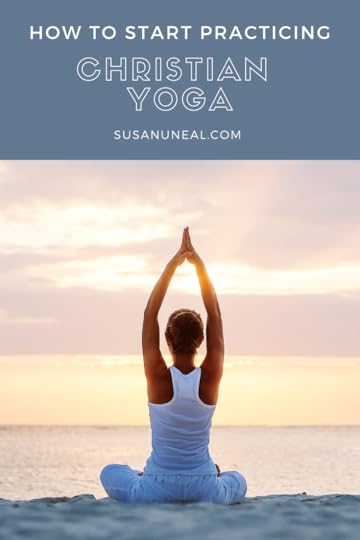
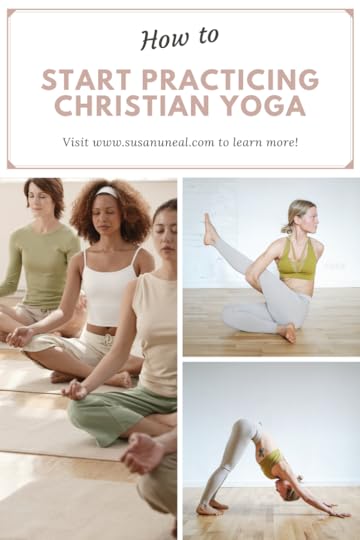
 The post What is “Christian” Yoga? | Combining Faith + Yoga first appeared on .
The post What is “Christian” Yoga? | Combining Faith + Yoga first appeared on .
June 30, 2022
Healthy Habits for Today’s Seniors
Healthy habits for today’s seniors begin with a positive attitude toward diet and exercise. Just because we are over fifty, sixty, seventy, eighty, or more doesn’t mean we sit in a rocking chair and wait for life to end. There’s too much of life to explore! We seize each moment with sound nutrition and an active lifestyle that keeps our minds and bodies performing like well-oiled machines.
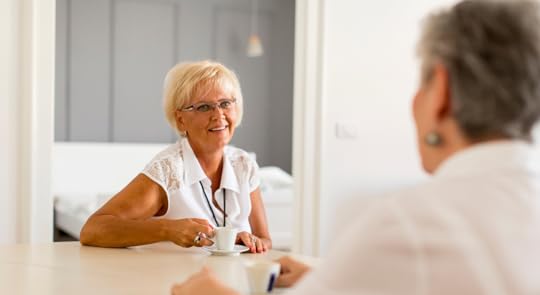
When I was fifteen years old, I decided to take care of my body for the long haul. I’d been a chubby child and faced all the ridicule that went with it. Educating myself on what my body needed to maintain a healthy weight meant eating to live, not living to eat.
My decision to take care of myself highlighted rising early and exercising before the school bus arrived. Those habits have stayed with me for seven decades. I believe my body is the temple of God, and I’m a steward of His holy gift (1 Corinthians 6:19.)
If we are motivated to get healthy and stay healthy, it’s not too late to embark upon a lifestyle that gives us purpose and meaning. Perhaps a goal is to shed a few unwanted pounds, or add back the extra weight an illness may have snatched from our body. Even if we’ve never considered our food intake or activity, this post may open our eyes.
Before moving forward:Check with your doctor and discuss expectations.Request blood work to make sure your body is in fine shape.Ask your doctor for vitamin and supplement recommendations.Plan a sensible diet and exercise plan.Enlist an accountability partner.Purchase the proper equipment/shoes for the activity.Subscribe to a respected online website that focuses on health care for the aging.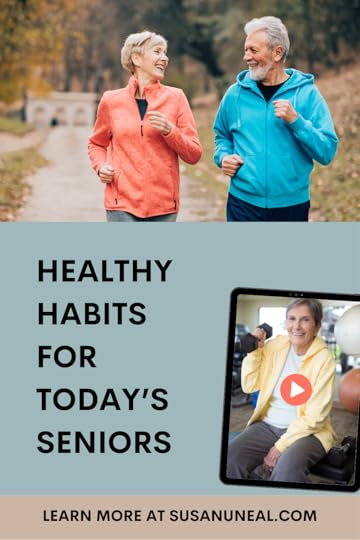
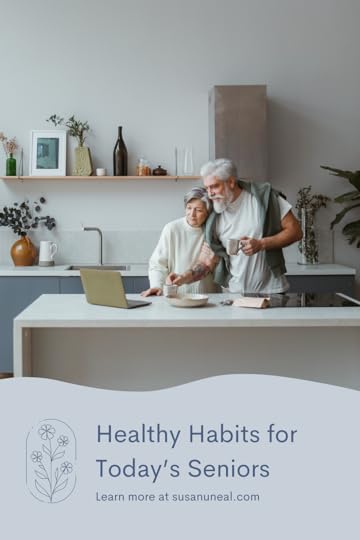
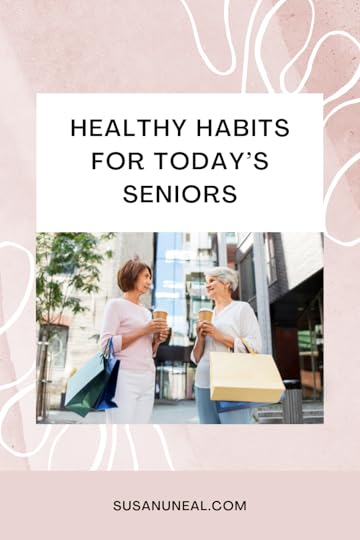 Food choices
Food choicesOur aging bodies thrive on fruits, vegetables, dairy, protein, and whole grains. Simple, but when we add extra fat, salt, sugar, and carbohydrates, our bodies will rebel over time and not in ways we enjoy. We are what we eat. Choose wisely.
If we are diabetic, gluten-free, or have other health issues that limit our intake, that’s okay. We choose or substitute foods to keep us feeling good and ensure our medical reports shine. Deliberately eating or drinking things that make us feel badly isn’t wise.
Sodium can be a killer. Literally. Our saltshakers are not the worst problem. Consuming processed foods and eating out adds far more sodium than is healthy at any age. Cutting back can be as easy as cooking from proven recipes and limiting restaurants to special occasions. However, some organic and whole foods eateries are selective in the preservatives that enhance their dishes.
Some people have never experienced a weight problem and saw no reason to educate themselves on what goes into their bodies. Now is the time to take notice. Take the time to read product labels and recipes for a huge nutritional payoff with dividends that money can’t buy.
It’s okay to be picky, and I fall under that category. I don’t care for the taste of a huge list of foods: beets, milk, egg yolks, red meat, white bread, white rice, potatoes, watermelon, or any kind of melon, to name a few. Weird, I know. But I can find the nutrients my body requires in multiple ways. I never met a green vegetable I didn’t like. Nut butters are my friend. My point is, make choices that suit your tastes and cause the nutritionist to smile.
Detoxing and/or intermittent fasting have proven to help the body’s overall function. If this is of interest in your new diet regimen, consult with your doctor before embarking on a habit that could be potentially harmless.
HydrateThe average adult body contains approximately 60% water, and as we get older, the percentage decreases. Lean muscle contains more water than fat, making water a sensible alternative to sugary or artificially sweetened beverages. When we don’t have enough water, we’re tired and can be plagued with headaches. Don’t forget that fresh produce contains a lot of water, so your body is happy and healthy.
Balance is the key to living well and enjoying life.Denying ourselves an occasional treat can cause a grumpy old person who forgot the pleasure of licking an ice cream cone on the hottest day of the year or blowing out the candles on a birthday cake and taking a swipe of frosting.
Vitamins and minerals are nuggets of gold.Big tip! Vitamins and minerals do not add to our life span. But they can add to the quality of life. The best source of supplements is in food, but that isn’t always possible. Also, the extra nuggets of power we took when we were younger should change as we age.
Our bones become more brittle, and calcium and vitamin D help slow down the process and fight osteoporosis. Stress is another factor in which supplements like vitamin B can aid in appropriate mental and emotional processing.
Selecting the vitamin and mineral brands can be a dilemma. Do we choose the least expensive or the most expensive? Choose the brand that eliminates or has few preservatives and extras not needed by the body.
Always check with your doctor or nutritionist about what is best and inquire about potential side effects. Taking too many or the wrong vitamins and minerals can do more harm.
How do I choose the right exercise?Some of us have exercise limitations that curb our type or level of activity. Limitations do not prohibit us from conditioning our bodies; they simply mean we understand our restrictions and find alternatives.
I believe varying what we do in our activities is a plus for our bodies. Walking may be your favorite form of exercise, and you have walking buds to join you. That makes the activity fun. I’m a fan of hiking. Grabbing a helmet and pedaling around the neighborhood may give you the extra boost your body needs. Wonderful. Some prefer a gym with a person who coaches seniors—now I’m jealous.
Various forms of exercise are available, no matter our age or disability. Determination and a positive attitude to change and maintain a healthy lifestyle is a win-win situation for all of us. Our God gave us bodies to move, minds to think, and food to maintain physical and mental health.
Are you ready to get started?
Seeking more information about health and wellness?What Does a Healthy Lifestyle Really Mean? by Rebecca Barlow Jordan
Maintaining a Healthy Lifestyle by Sherri Downs
How to Rebound from a Serious Illness by Tracy Crump
Healthy Eating for Your Body, Soul, and Spirit by Stephanie Pavlantos
Health and Spiritual Books by Susan U. Neal
Healthy Aging: Beyond 50 by the Mayo Clinic
Disability Exercises: Exercising for Persons with Disabilities by DisabledWorld
Physical Activity for People with Disability by the Centers for Disease Control and Prevention
A Senior’s Guide to Physical and Mental Fitness by Anthony Martin
About the AuthorDiAnn Mills is a bestselling author who believes her readers should expect an adventure. She is a storyteller and creates action-packed, suspense-filled novels to thrill readers. Her titles have appeared on the CBA and ECPA bestseller lists; won two Christy Awards; and been finalists for the RITA, Daphne Du Maurier, Inspirational Readers’ Choice, and Carol award contests.
DiAnn is a founding board member of the American Christian Fiction Writers, a member of Advanced Writers and Speakers Association, Mystery Writers of America, Sisters in Crime, and International Thriller Writers. DiAnn continues her passion for helping other writers be successful. She speaks to various groups and teaches writing workshops around the country.
DiAnn’s next release is Concrete Evidence https://diannmills.com/books/concrete-evidence/
Connect with DiAnn on her various social media platforms here: www.diannmills.com
The post Healthy Habits for Today’s Seniors first appeared on .
June 23, 2022
Intermittent Fasting Helps You Lose Belly Fat
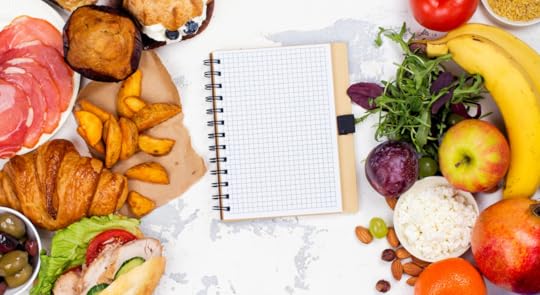
Scientific studies prove that intermittent fasting (IF) is beneficial for the body and mind. I’ve been practicing it for years. IF occurs when you eat within a specific window of time. I prefer a nine to ten-hour window. I eat dinner between 6 and 7 pm and fast until the next morning around 10 am.
IF produces incredible health benefits. If you want to give it a try, a food journal can help. My book Healthy Living Journal, helps you figure out which time period suits you best. Some people like to eat in an eight-hour window and fast the other sixteen hours, but that is too long of a fasting period for me. You could play around with different time periods to see what suits you best.
BenefitsNumerous studies show that intermittent fasting is beneficial. Check out these benefits:
Helps you lose weight and more specifically belly fat.Increases your metabolism which causes you to burn more calories.Reduces blood sugar levels which helps prevent diabetes and metabolic syndrome.Improves blood pressure and cholesterol levels.Helps fight inflammation in the body.Supports cell repair in areas of the body that needs it.May protect against cancer and dementia.Tips for Success
Here are some suggestions for attaining success with intermittent fasting.
In the morning, drink two glasses of water upon awakening.Go about your morning as usual, but do not eat breakfast.It is best to stay busy.Drink your usual caffeinated beverage.Every time you start to get hungry, drink another glass of water so you can hold off from eating breakfast for as long as possible. I try to go until 10 am, which works well for me.Ride out the hunger waves.Know the difference between needing and wanting to eat.Listen to your body. If you experience intense hunger, fatigue, or a headache—eat.When you eat, make sure it is a low-carbohydrate diet as recommended in my #1 Amazon best-seller 7 Steps to Get Off Sugar and Carbohydrates .Eat a healthy dinner that includes a wholesome protein source as well as loads of vegetables. You want to be satisfied but not stuffed. After dinner, don’t eat anything.In the evening, try to keep your mind off of food by watching a movie or reading a book.
You want to be satisfied and not hungry during the nine to ten-hour eating window. Eating nutritious foods such as lean meats and vegetables is vital. Nutrient-rich foods keep your blood sugar level steady and prevent nutritional deficiencies. Do not eat processed foods, refined carbohydrates, or desserts. Don’t waste your calories on them.
Eat God’s foods and not the food manufacturers. When you are about to sit down and eat, pray and assess your plate. Does it resemble the food that comes out of the garden or off the ranch? If not, don’t eat it. Food industries want us to consume more of their fabricated food items. They do not care about our health; they are only concerned about their bottom-line. They add sugar and salt to entice us to eat more.
In addition, it is vital to stay hydrated. But how much water should you consume? Your weight determines this. You should drink half your weight in ounces. For example, when you divide your weight by two, it equals the number of ounces of water you should drink each day. So a 130-pound person should drink sixty-five ounces of water. Pour the amount of water your body needs into a pitcher in the morning and drink it throughout the day. I drink at least a third of my daily water consumption before breakfast. Therefore, I am not hungry in the morning, and it is easy to fast until 10 am.
Pay attention to what your body is telling you as you figure out intermittent fasting (IF). Charts within your Healthy Living Journal will help you evaluate your sleep, energy level, mood, emotional health, as well as your water intake and exercise. This tool will help you figure out if IF is for you.
It takes about a month of trying IF to determine whether it is a good fit for you. If you are taking medication or under the care of a physician, you should consult with your doctor regarding this time-restricted eating practice. Intermittent fasting is not for everyone, but I hope you enjoy its benefits.
Intermittent fasting is an excellent weapon in the battle for weight loss. Imagine how you would look and feel after you shed your unwanted pounds. Say good-bye to the sugar mood swings and welcome a healthier you.
~Pin for Later~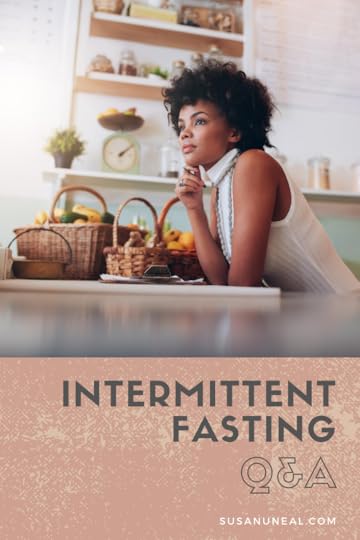

 The post Intermittent Fasting Helps You Lose Belly Fat first appeared on .
The post Intermittent Fasting Helps You Lose Belly Fat first appeared on .
June 9, 2022
How to Rebound From A Serious Illness
My illness started out like any other intestinal virus, not pleasant but certainly not serious. My symptoms abated around 2 am. Later that morning, I ran a low-grade fever and felt like a wrung-out dishrag, my usual modus operandi after a stomach bug. However, as the day wore on, my fever rose, and the stomach soreness I’d assumed was from heaving all night gravitated to my lower right abdomen. Uh oh. As a former nurse, I knew that could indicate appendicitis. Read on to learn how to rebound from a serious illness like I did.
“Honey,” I told my husband, “Maybe we’d better go to the emergency room. If nothing else, I’m sure I’m dehydrated.” A little IV fluid would soon set things right.
But lab work and a CT scan confirmed I did, indeed, have appendicitis. What? I didn’t have time for surgery. My mom required twenty-four-hour care. Even though we had caregivers, I went to her house twice daily to give injections and put her to bed. At the time, she also had a special intravenous line through which she was receiving nutritional supplementation and antibiotics, which I administered. My dad needed me in a myriad of ways, and the caregivers depended on me to do the shopping and coordinate everything. I was indispensable. Wasn’t I?
Surgery revealed a perforated appendix. I was sicker than I realized and spent a week in the hospital, along with several more weeks recuperating. Yes, it was hard to sit still at home when my parents needed me. But friends and family pitched in to help them during my absence. Giving myself time for proper recovery ensured I’d be able to assist them in the long run.
As much as we try to manage our health, serious illness can take us down without warning. How do we rebound, especially when others are depending on us?


 Reasonable Exercise
Reasonable ExerciseI enjoy taking long walks around the lakes in our subdivision. I don’t mind saying, I was proud of my pre-surgery legs, but by the time I was discharged from the hospital, my calves looked like pancakes. Floppy pancakes.
According to WebMD, as little as two weeks of inactivity can cause a 30 percent loss of muscle strength, even in young people. Although the hospital staff had me up and walking the halls soon after surgery, I was nowhere near ready to resume my usual two-mile-a-day treks at home, much less fitness training. After any surgery, injury, or prolonged illness, we’re wise to approach exercise with caution. Slowly increasing activity while heeding our bodies’ signals to slow down or stop helps us heal without doing further damage, but heaven help us if we do too much.
A friend found that out the hard way. After major abdominal surgery, she followed her doctor’s directive not to bend or lift, but staying on her feet too long during a holiday with family caused bleeding to resume and put her back in bed. When she started walking the second week post-op as instructed, she didn’t realize that meant “around the inside of the house, not half a mile three days in a row with the dog.” Another setback.
ercise is vital for recovExery and prevents serious complications, such as blood clots, but listen to your body. Sleep downstairs, recruit someone else to walk the dog, and leave the Christmas tree up until Easter if you have to.
Recuperative DietHealthy eating is part of a healthy lifestyle anytime, but especially when we’re healing. For one thing, our bodies need more protein to repair or replace damaged tissues after surgery or injury. Regardless, our stomachs may not be ready for a juicy steak or blackened salmon right after an illness or surgery. Remember, other sources of protein, such as dairy products, eggs, legumes (dried peas and beans), and nuts and seeds (including quinoa).
Though carbohydrates have taken a bad rap lately, they are the quickest source of energy and are therefore vital for healing. Many conditions, such as fever, deplete the body of calories, while others require increased calorie intake to promote healing, as is the case with severe burns. Carbohydrates are the best source of those calories. However, simple sugars and refined carbohydrates may cause blood sugar spikes that lead to inflammation. So stick with complex carbs like whole grains.
Whenever my sisters and I were sick, our grandmother blended a drink made with egg, milk, sugar, and vanilla, her version of a protein smoothie. Though I wouldn’t recommend consuming raw eggs, we never suffered, and we always looked forward to the treat. Poached egg on toast is another old-fashioned remedy and often easy on the stomach. Both combine protein and carbs.
Getting our nutrition is not always easy during recovery. Nausea can interfere with appetite, and anesthesia may affect the way food tastes. (Ice cream—my comfort food—suddenly tasted like regurgitated baby formula following my surgery.) It helps to consume frequent small meals and stick with bland foods for a while. Don’t forget to drink plenty of water and other healthful liquids and augment nutrition with vitamin and mineral supplements.
Restorative RestRest is imperative to recovery. In the best of times, we need seven to eight hours of sound sleep to maintain health. When we’ve been ill, we need even more. While we sleep, our bodies repair cells, reduce inflammation, and boost the immune system. It sounds like a prescription straight from heaven.
Unfortunately, many factors following illness interfere with sleep. Pain is one. Sometimes over-the-counter or prescription medications relieve our pain. At other times, we may have to be more resourceful. I know of patients who soak in hot tubs or Epsom salt baths before going to bed, affording them a good night’s sleep. Some find relief with heating/vibration pads.
Cough or other breathing difficulties can also interrupt sleep. In addition to medications, sleeping in a recliner or on several pillows may alleviate the symptoms enough to allow for sound sleep. And keep the effects of caffeine in mind. If sleep is already elusive, avoid chocolate and carbonated tea, coffee, or sodas.
Melatonin, a sleep aid, is often used to induce a good night’s sleep. Produced naturally by the body during sleep, it is also found in foods that enhance sleep, such as milk, eggs, and nuts. There has even been evidence that melatonin reduces inflammation and some types of pain, increasing its effectiveness as a sleep aid. It’s not a cure all but may be worth investigating, though it can interfere with other medications and is not a good long-term solution.
Reviving FaithSudden illness or injury throws our lives out of kilter. One of the most overlooked keys to recovery is spiritual health. Some studies have shown that strong faith combats stress along with its resultant ill effects, including high blood pressure, increased heart rate, and neuro-hormonal changes. Stress not only generates problems of its own but also hinders healing and recovery. Strong religious convictions help mitigate those effects. Even more studies have shown an encouraging correlation between faith and mental health.
Beyond the quantifiable physical and mental benefits, faith produces a peace and hope that doctors and scientists can’t explain. As Jesus said in John 14:27, “Peace I leave with you, my peace I give unto you: not as the world giveth, give I unto you. Let not your heart be troubled, neither let it be afraid.” No amount of medication, treatment, or physical therapy has the healing properties that allow us to rebound from illness, like knowing Jesus does.
Recovering HealthThe body has an amazing ability to recover, if we just get out of the way and let it. But we have to remember it’s a process and takes time. Exercise, diet, rest, faith—nothing new to a healthy lifestyle, but in recovery from health challenges, they take on greater significance. When we intentionally apply these four pillars to our lives, we can rebound from serious illness more smoothly and rapidly.
About the AuthorTracy Crump dispenses hope in her multi-award-winning book, Health, Healing, and Wholeness: Devotions of Hope in the Midst of Illness. A former ICU nurse and homeschool mom, she cared for her parents and 100-year-old mother-in-law. Tracy has published hundreds of articles, devotions, and short stories and offers caregivers encouragement and practical tips in her new blog, Caregivers Corner. Connect with Tracy at TracyCrump.com.
The post How to Rebound From A Serious Illness first appeared on .June 1, 2022
Four Keys to Combat the Effects of Stress and Anxiety on the Body
The effects of stress on my body lingered for months. Red, painful hives erupted beneath the top
layer of skin on my hands and arms; visible but unreachable. Finally, after enduring weeks of
itching and peeling skin, medication alleviated some of the discomfort. Perhaps your child or teen wrestles with anxiety. Or, in our post-pandemic world, you may struggle with chronic stress.

According to the National Institutes of Health, stress and anxiety lead to more than seventy-five
percent of the symptoms and diseases doctors treat. This includes issues such as headaches,
chronic pain, digestive issues, high blood pressure, diabetes, and even some cancers.
With such an array of problems associated with stress, how can we equip ourselves against it?
Begin by recognizing that some stress is positive. My son and his wife, for example, look
forward to the birth of their first child. While planning for a baby and caring for a newborn
fosters a level of stress, this sort of experience creates joy and anticipation. However, acute and
chronic stress does not.



Acute stress is an exciting, irritating, or mildly unfavorable event that can flood the body with
cortisol. Initiated by events or circumstances such as brief illness, work-related presentations, or
even fair rides. However, stress hormones soon normalize.
More pervasive, chronic stress involves either intensity or frequency. Examples include such
disturbing events and circumstances as pandemics, divorce, abuse, a punitive boss, loneliness, or
chronic illness.
Stress involves a reaction to circumstances or occurrences, while anxiety is a response to real or
imagined concerns and worries about the past or future. Unfortunately, the effects of chronic
stress and anxiety on the body are similar.
Stress and anxiety both result in similar physical side effects. The Mayo Clinic records the most
immediate ramifications:
Headaches
Stomach aches
Fatigue
Insomnia
Skin issues such as eczema and hives
Loss of sex drive
Increased illness
Significant weight gain or weight loss
As mentioned earlier, long-term consequences include more serious issues, such as high blood
pressure, autoimmune disorders, and even some cancers.
My husband served boots-on-the-ground for twelve months. Every day, thoughts about his safety
intruded while I attempted to juggle the needs of my four children.
Pasting a smile on my face, I denied the burden of chronic stress on my weary soul but still
experienced several of the following:
Feelings of hopelessness/helplessness
Difficulty getting out of bed
Disinterest in activities I once enjoyed
Difficulty concentrating
Increased anxiety and/or depression
Can you relate? Perhaps your stress level is at an all-time high as you mentally check off
multiple areas from each list in this article. Maybe you’ve begun imagining your next doctor’s
visit.
Overcoming stress and anxiety can be drilled down to the principles of resilience.
1. Optimism: As a prisoner of a concentration camp during World War II, Corrie Ten Boom
understood chronic stress and anxiety. She and her sister, Betsy, survived unlivable
conditions. Forced to live in a crowded, flea-ridden hovel, Corrie complained to her sister.
Betsy, seeing beyond the circumstances expressed gratefulness for the bugs.
Not long after their conversation, soldiers refused to inspect the space due to the flea
infestation. As a result, the two sisters continued hosting their weekly Bible study
undisturbed. While Betsy died before the prisoners were released, her optimism forever
changed Corrie Ten Boom.
Dr. Michelle Bengston also demonstrates optimism to all who observe her life. Having
traveled a long journey with cancer, she recently released a devotional entitled Today is
Going to Be a Good Day: 90 Promises from God to Start Your Day off Right. No matter her
health situation or circumstance, my friend knows that because God’s promises are true,
each day holds beauty. Optimism is the first key to overcoming chronic stress, but more is
needed.
2. Cognitive Flexibility: Social science confirms what scripture has told us for thousands of
years—the mind is powerful. “Do not be conformed to this world, but be transformed by the
renewal of your mind, that by testing you may discern what is the will of God, what is good
and acceptable and perfect” (Romans 12:12).
According to the National Science Foundation, at least seventy percent of our thoughts are
negative, and more than half of those are on repeat.
Developing cognitive flexibility involves reframing our perspective. For instance, I live with
fibromyalgia. A few years ago, the symptoms forced a decision. I either had to quit teaching
because my fibromyalgia made me too ill to continue, or I could choose to work from home
to tutor part-time and develop my ministry through writing and speaking. Do you notice the
difference between the two?
3. Active Coping: Passivity leads to a victim mentality and fosters helplessness. Do we believe
we are made in the image of God? Then we set goals to help ourselves care for our bodies,
minds, and spirits despite how we feel. Scripture tells us we “can do all things through
Christ” (Philippians 4:13).
Active coping looks like engaging in exercise, eating a healthy diet, and seeking resources
for yourself or your child or teen when anxiety becomes overwhelming. It may even involve
life coaching, counseling, or medication. Both knowledge and action must occur for active
coping to succeed.
4. Spiritual Life: It’s all about Jesus, isn’t it? Our core beliefs matter. Even the world and
secular science recognize the importance of “spiritual influences” and a personal moral
compass. Altruism, or making an impact in the lives of others, is a particularly important
aspect of this faith component.
James 2:17 reads, “Faith without works is dead.” Perhaps that is why our ‘doing’ for others
builds resilience in us. God designed us to sow love into the lives of others, and we
unknowingly receive the blessing.
Personal ‘soul care’ also impacts the management of and healing from chronic stress and
anxiety. Multiple studies indicate that private prayer improves optimism, reduces anxiety and
depression, and helps increase clarity of thought.
In a world of demands and deadlines, it can be challenging to make space for quiet moments
with God. But He created us for relationship with Him and even in those times, we receive
healing.
Matthew 11:28-30 reminds us that Jesus calls us away from stress to a place of rest, “Are you
tired? Worn out? Burned out on religion? Come to me. Get away with me and you’ll recover
your life. I’ll show you how to take a real rest. Walk with me and work with me—watch how I
do it. Learn the unforced rhythms of grace. I won’t lay anything heavy or ill-fitting on you. Keep
company with me and you’ll learn to live freely and lightly.”
Today, may we each release our burdens and walk in a place of freedom as we overcome stress
and cling to Christ.
For further reading, this blog contains 10 Techniques to Deal with Anxiety and this one provides
Physical, Mental, and Spiritual Ways to Reduce Anxiety.
Tammy Kennington is a writer and speaker familiar with the impact of trauma, mental health
issues, and parenting in hard places. Her desire is to lead women from hardship to hope and to
share the love of Christ with the young and young at heart. You can meet with Tammy as she
blogs each week at www.tammykennington.com or subscribe to receive a monthly dose of hope.
You can also connect with Tammy on:
Instagram Tammy L Kennington (@tammylkennington)
Twitter https://twitter.com/TammyKennington
Facebook Tammy L Kennington | Facebook
May 15, 2022
10 Techniques to Deal with Anxiety
Anxiety, the most common mental health diagnosis, is on the rise. There is a mental health crisis in the United States as one in four people experience some type of mental health disorder like depression, panic attacks, or anxiety according to Johns Hopkins Medicine. But how are we supposed to deal with anxiety?
Anxiety overcame me when the saleswoman asked, “Can I help you?” My face flushed and my voice stuck in my throat. I squeaked out a feeble, “No thank you.”
I don’t know why this situation triggered my anxiety. But it did. I needed a way to deal with it in the moment.

Anxiety is characterized by extreme stress and consuming thoughts of worry. It manifests itself in a physical nature. Some of the diverse symptoms of anxiety include:
nauseasweatinginsomnia irritabilityaggressionrestlessness racing heart hypervigilancelightheadednessshortness of breathtight chest muscles feelings of losing controlnumbness in hands, feet, or face,Anxiety is highly treatable, yet, only 37 percent of individuals who experience anxiety seek treatment. There is hope for those who suffer from anxiety, and there are simple techniques available to deal with it.


 What Causes Anxiety?
What Causes Anxiety?According the Mayo Clinic, anxiety is caused by a variety of things. There are some medical causes like heart disease, diabetes, hyperthyroidism, and respiratory disorders. Risk factors for anxiety include trauma, prolonged stress, personality, other mental health disorders like depression, family history, and drug and alcohol use.
What Prevents Anxiety?A healthy lifestyle that includes healthy eating, regular exercise, downtime, and good sleep while avoiding alcohol use are helpful in fending off anxiety. A healthy lifestyle sharpens our minds and increases a sense of well-being and happiness. That said, anxiety is sneaky. It may still creep into our mind and body despite doing everything right.
What Techniques Deal with Anxiety?When anxiety is triggered, like my experience while shopping, there are somethings we can do in the moment to deal with it. In my book, Messy Hope: Help Your Child Overcome Anxiety Depression, or Suicidal Ideation I list 10 techniques that can be used to battle and reduce anxiety.
Agree with anxiety. Say to yourself, “Yes, I do feel anxious. Even though I feel anxious, it is okay. I am safe, God is with me.”Try flooding. Engage in situations that make you anxious and reassure yourself it is okay. Have a support person who will be with you.Evaluate the fear. Make a list of your worries. Figure out what can be controlled. Control the things you can.Move that body. Exercise to release endorphins. This will alter your mind positively by relieving tension and anxiety.Turn on the tunes. Put on some praise music, sing, and dance.Get grounded. Practice mindfulness and being present. Use your sense to identify and concentrate on the things around you.Make a decision. Indecision adds to anxiety.Hum. Yep, hum. Stimulate the vagus nerve (located on either side of your voice box). Humming interrupts the flight, fright, or freeze mode.Be silly. Humor releases endorphins that combat stress and anxiety.Use breathing techniques. Slowly inhale through your mouth and exhale through your nose.Humming is something we can do in the middle of the anxious moment. (It worked well for me at the mall.) Breathing into a paper bag is also recommended but not many of us haul around a paper bag. Plus the saleswoman would have thought I was totally crazy that her normal question, “Can I help you?” caused me to breathe into a paper bag.
How Can I Help My Loved One Who Experiences Anxiety?The best place to start is by listening. While you are listening, keep in mind these 5 things.
Avoid shaming, “If you had more faith this wouldn’t happen.”Avoid suggestions, “Have you prayed about this?” You can bet they have. And perhaps even prayed without ceasing. Don’t discount, “This isn’t so bad, at least you have____.” Continue to be present. Say, “I am here with you. You can get through this.”Offer prayer. Tell them you will pray for them.Keep in mind you are not the sufferer’s therapist or doctor. You are their support system Don’t try to fix them. Instead offer that listening ear and needed encouragement to get help. Anxiety can be overcome.
What Should I Do if I Have Anxiety?Anxiety symptoms are real and not imagined. But the worry and fear that triggers anxiety is exaggerated. It is helpful to identify what is fact and what is fear. But, in the middle of an anxious moment having another person point out the fear isn’t logical, nor is it helpful.
Anxiety is an equal opportunity malady. People of faith are not immune to it. In scripture, Paul advised Timothy, who experienced anxiety, “Stop drinking only water, and use a little wine because of your stomach and your frequent illnesses” (1 Timothy 5:23, NIV). Timothy, a man of strong faith, a pastor and a teacher, had a nervous and sensitive stomach, indicators he suffered from anxiety.
Here are two bonus tips. There are times it is perfectly fine to avoid situations that cause anxiety. Finally, be one of the 37 percent to get help. Anxiety can be dealt with. We can stop this mental health trend. There is hope.
LORI WILDENBERGLori is passionate about helping families build connections that last a lifetime. She’s a national speaker, licensed parent-family educator, and leads the popular MOMS Together Facebook Page and Group. Lori is an award-winning author or co-author of 6 books including her most recently published book, Messy Hope: Help Your Child Overcome Anxiety, Depressions, or Suicidal Ideation. To find out more go to loriwildenberg.com
The post 10 Techniques to Deal with Anxiety first appeared on .April 14, 2022
EWG’s 2022 Clean Fifteen™ and Dirty Dozen™ Lists
Every year, the non-profit Environmental Working Group (EWG) produces the notorious produce lists called the Dirty Dozen and Clean Fifteen. The EWG does an excellent job of determining the number of pesticides in our food-based upon 35,000 samples tested by the U. S. Department of Agriculture and the Food and Drug Administration. Here’s EWG’s 2022 Clean Fifteen and Dirty Dozen Lists.

They tested produce items for pesticide residue after the produce was washed and peeled. The Fifteen produce items with the least pesticides are called the Clean Fifteen, and the 12 items with the most pesticides are known as the Dirty Dozen. Take a screenshot on your phone, of these two lists so you can easily access them when shopping. The lists help you remember which fruits and vegetables you need to buy organic (Dirty Dozen) and which ones you don’t (Clean Fifteen). The EWG recommends you buy organic fruits and vegetables from the Dirty Dozen list.
Pin for Later

 EWG’s 2022 Dirty Dozen
EWG’s 2022 Dirty Dozen StrawberriesSpinachKale, Collard & Mustard GreensNectarinesApplesGrapesBell & Hot PeppersCherries PeachesPearsCeleryTomatoes
StrawberriesSpinachKale, Collard & Mustard GreensNectarinesApplesGrapesBell & Hot PeppersCherries PeachesPearsCeleryTomatoes Strawberries continue to be on the top of the Dirty Dozen list because pesticide residue was found on 99% of the sampled, washed strawberries. Collard and mustard greens were added to the Dirty Dozen list this year. Even after washing kale and other leafy greens, the EWG found that 86% of the samples contained questionable levels of toxic pesticides. Some of those pesticides caused cancer. So be sure to purchase organic produce found on this list. I show you how to grow lettuce in a container in my blog, Seven Steps to Create Your Own Vegetable Garden.
A couple of years ago, grapes were added to the Dirty Dozen list. If you drink grape juice or wine, you are probably drinking pesticides too. Therefore, we should purchase organic. I found a great organic, biodynamic vineyard in Oregon called Troon Vineyard.
EWG’s 2022 Clean Fifteen AvocadosSweet CornPineappleOnionsPapayaSweet Peas FrozenEggplantAsparagusCauliflowerCantaloupeBroccoliMushroomsCabbageHoneydew MelonKiwi
AvocadosSweet CornPineappleOnionsPapayaSweet Peas FrozenEggplantAsparagusCauliflowerCantaloupeBroccoliMushroomsCabbageHoneydew MelonKiwiIf a thick-skinned vegetable is not on the list, you don’t necessarily need to purchase organic. However, if it’s a thin-skinned produce item, or you eat the skin of the fruit, be sure to buy organic.
Besides the Dirty Dozen list, the EWG creates consumer guides that score the safety of cosmetics, cleaning supplies, tap water and more. Their goal is to empower you to live a healthier life. Check out the following consumer guides at https://www.ewg.org/consumer-guides.
Tap Water DatabaseEWG Verified (personal care products)Skin Deep (cosmetic database)Healthy Cleaning Guide (cleaners)Solar Energy GuideFor the interactive tap water guide, when I typed in my zip code, I found my water supply had three contaminants that were above the EWG health guidelines and all three caused cancer. The guide also provided guidelines for which type of water filter to use to remove the specific contaminant.
The Environmental Working Group’s lists and guides are helpful in living a healthier lifestyle.
The post EWG’s 2022 Clean Fifteen™ and Dirty Dozen™ Lists first appeared on .


